船员面试指南
- 格式:ppt
- 大小:350.50 KB
- 文档页数:46
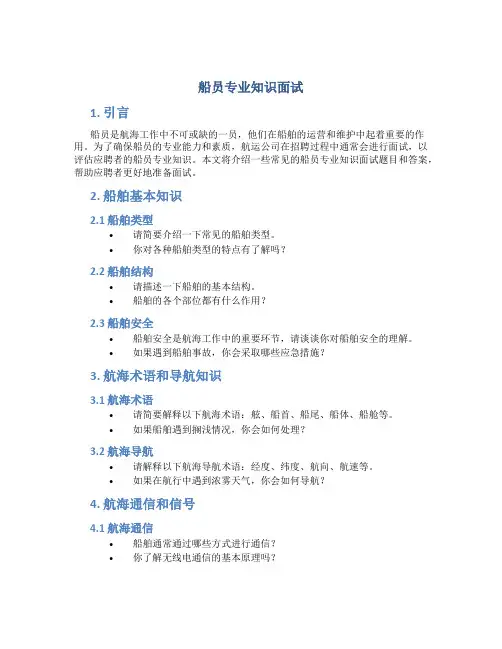
船员专业知识面试1. 引言船员是航海工作中不可或缺的一员,他们在船舶的运营和维护中起着重要的作用。
为了确保船员的专业能力和素质,航运公司在招聘过程中通常会进行面试,以评估应聘者的船员专业知识。
本文将介绍一些常见的船员专业知识面试题目和答案,帮助应聘者更好地准备面试。
2. 船舶基本知识2.1 船舶类型•请简要介绍一下常见的船舶类型。
•你对各种船舶类型的特点有了解吗?2.2 船舶结构•请描述一下船舶的基本结构。
•船舶的各个部位都有什么作用?2.3 船舶安全•船舶安全是航海工作中的重要环节,请谈谈你对船舶安全的理解。
•如果遇到船舶事故,你会采取哪些应急措施?3. 航海术语和导航知识3.1 航海术语•请简要解释以下航海术语:舷、船首、船尾、船体、船舱等。
•如果船舶遇到搁浅情况,你会如何处理?3.2 航海导航•请解释以下航海导航术语:经度、纬度、航向、航速等。
•如果在航行中遇到浓雾天气,你会如何导航?4. 航海通信和信号4.1 航海通信•船舶通常通过哪些方式进行通信?•你了解无线电通信的基本原理吗?4.2 航海信号•船舶上常用的信号灯有哪些?•你知道国际通用的SOS求救信号吗?5. 船舶机械知识5.1 船舶主机•船舶主机的作用是什么?•你了解柴油机的工作原理吗?5.2 船舶辅机•请列举一些船舶上常见的辅机设备。
•你了解船舶辅机的维护和保养方法吗?6. 总结船员专业知识面试是评估应聘者是否具备航海工作所需知识和技能的重要环节。
在准备面试时,应聘者需要对船舶基本知识、航海术语和导航知识、航海通信和信号、船舶机械知识等方面有所了解。
本文介绍了一些常见的面试题目和答案,希望能对应聘者的面试准备有所帮助。
最后,祝愿所有应聘者在面试中取得好的成绩!。
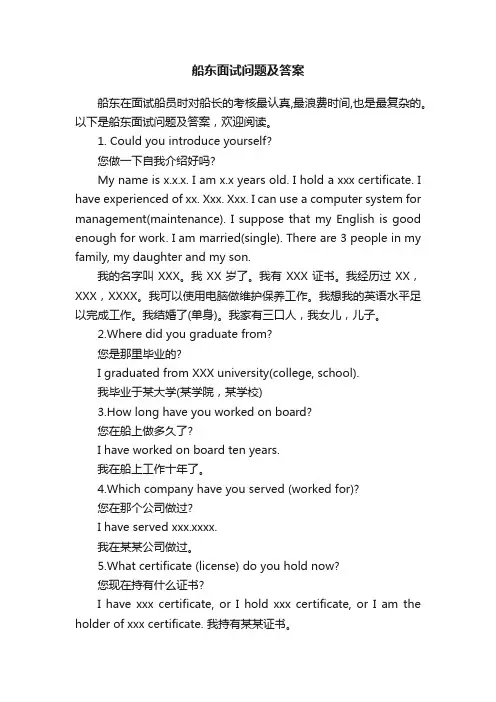
船东面试问题及答案船东在面试船员时对船长的考核最认真,最浪费时间,也是最复杂的。
以下是船东面试问题及答案,欢迎阅读。
1. Could you introduce yourself?您做一下自我介绍好吗?My name is x.x.x. I am x.x years old. I hold a xxx certificate. I have experienced of xx. Xxx. Xxx. I can use a computer system for management(maintenance). I suppose that my English is good enough for work. I am married(single). There are 3 people in my family, my daughter and my son.我的名字叫XXX。
我XX岁了。
我有XXX证书。
我经历过XX,XXX,XXXX。
我可以使用电脑做维护保养工作。
我想我的英语水平足以完成工作。
我结婚了(单身)。
我家有三口人,我女儿,儿子。
2.Where did you graduate from?您是那里毕业的?I graduated from XXX university(college, school).我毕业于某大学(某学院,某学校)3.How long have you worked on board?您在船上做多久了?I have worked on board ten years.我在船上工作十年了。
4.Which company have you served (worked for)?您在那个公司做过?I have served xxx.xxxx.我在某某公司做过。
5.What certificate (license) do you hold now?您现在持有什么证书?I have xxx certificate, or I hold xxx certificate, or I am the holder of xxx certificate. 我持有某某证书。


海员面试的诀窍详解很多海员,尤其是第一次接受面试的船员,面试时精神紧张是很普遍的现象。
有时,应试船员手势过多,甚至说到激动时手指直指船东;有的唾液飞扬;有的不自然地翘起了二郎腿,好象他在面试考官一样。
这些都会给船东留下很不好的印象。
笔者的建议是,想要解除自己面试时的紧张感,最好要让自己有一定的面试经验。
听说,很多船员为了让自己有面试经验,尽管没有船东面试的实战经验,却通过去其他非船员公司的其他职位面试来学面试经验。
还有的船员在面试前反复练习握手、自我介绍,并让别人评判自己的表现,我认为这是克服面试紧张的非常好的办法。
面试中,考官说话时要仔细倾听、不抢话、不说多余的话。
其实,作为船员,即使你在学校学到的理论知识再杂扎实,船上实践知识再丰富,仍可能会在面试中遇到答不上来的问题。
硬着头皮乱说一通,掩饰自己的无知,这是极不明智的;回避问题东拉西扯不相干的事情,也是下策。
最明智的措施是坦白承认自己不懂。
注意自己的肢体语言:用点头的方式让考官明白你听懂了他的问题或对考官的见解表示同意;用微笑的方式表示你对考官的善意以及你一直在认真倾听考官的问题;适当地在椅子上向前欠一下身(或者向考官挪近一点)来表示你非常专注,并对问题非常感兴趣;偶尔用手势来强大你讲的某件事或某个观点。
但是,上述肢体语言的使用过程中,切勿矫枉过正。
下面一些肢体语言被视为不雅的行为:身体扒在桌子上或过分前倾、衣服口袋里叮当作响;手指在桌子上敲,或胳膊在扶手上动;摆弄自己的头发、首饰或手表等;揪耳朵、胡子或鬓角等;翘二郎腿;面部神经抽动;在椅子上摇晃个没完没了;目光在室内不停地扫视;心神不定地摆弄衣服;来回擦嘴、鼻子或嘴与鼻子之间的位置;绞扭双手、摆弄手里的东西或指*;咬抓耳挠腮;抓弄手指等等。
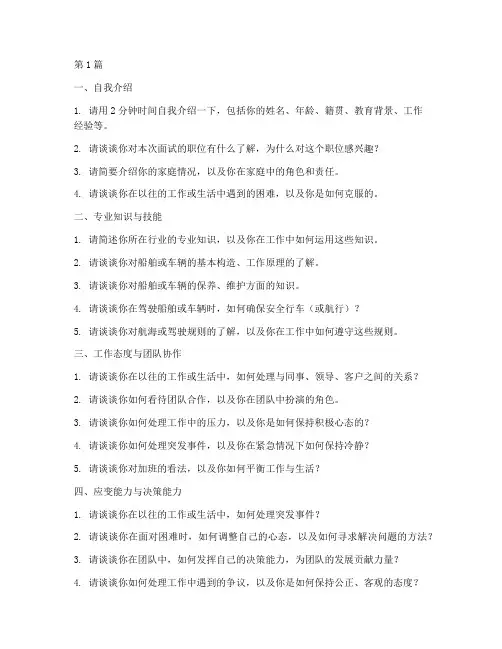
第1篇一、自我介绍1. 请用2分钟时间自我介绍一下,包括你的姓名、年龄、籍贯、教育背景、工作经验等。
2. 请谈谈你对本次面试的职位有什么了解,为什么对这个职位感兴趣?3. 请简要介绍你的家庭情况,以及你在家庭中的角色和责任。
4. 请谈谈你在以往的工作或生活中遇到的困难,以及你是如何克服的。
二、专业知识与技能1. 请简述你所在行业的专业知识,以及你在工作中如何运用这些知识。
2. 请谈谈你对船舶或车辆的基本构造、工作原理的了解。
3. 请谈谈你对船舶或车辆的保养、维护方面的知识。
4. 请谈谈你在驾驶船舶或车辆时,如何确保安全行车(或航行)?5. 请谈谈你对航海或驾驶规则的了解,以及你在工作中如何遵守这些规则。
三、工作态度与团队协作1. 请谈谈你在以往的工作或生活中,如何处理与同事、领导、客户之间的关系?2. 请谈谈你如何看待团队合作,以及你在团队中扮演的角色。
3. 请谈谈你如何处理工作中的压力,以及你是如何保持积极心态的?4. 请谈谈你如何处理突发事件,以及你在紧急情况下如何保持冷静?5. 请谈谈你对加班的看法,以及你如何平衡工作与生活?四、应变能力与决策能力1. 请谈谈你在以往的工作或生活中,如何处理突发事件?2. 请谈谈你在面对困难时,如何调整自己的心态,以及如何寻求解决问题的方法?3. 请谈谈你在团队中,如何发挥自己的决策能力,为团队的发展贡献力量?4. 请谈谈你如何处理工作中遇到的争议,以及你是如何保持公正、客观的态度?五、职业道德与责任心1. 请谈谈你对职业道德的理解,以及你在工作中如何践行职业道德?2. 请谈谈你对责任心的理解,以及你在工作中如何承担起自己的责任?3. 请谈谈你如何看待工作中的诚信,以及你是如何保持诚信的?4. 请谈谈你如何看待工作中的公平、公正,以及你是如何做到公平、公正的?六、薪酬与福利1. 请谈谈你对薪资的要求,以及你期望的薪资水平。
2. 请谈谈你对福利待遇的要求,以及你期望的福利待遇。

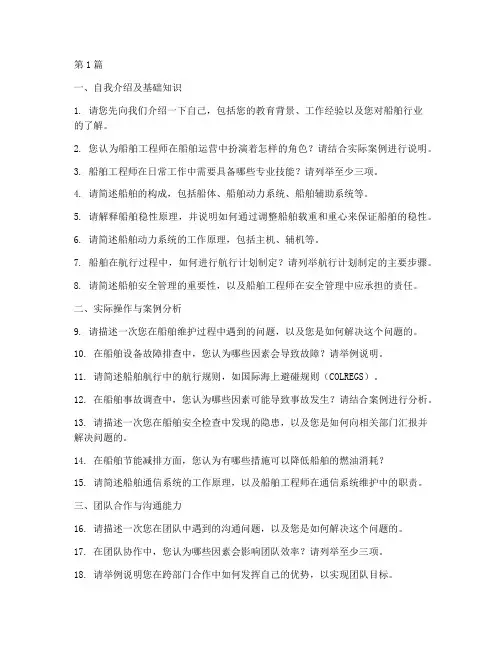
第1篇一、自我介绍及基础知识1. 请您先向我们介绍一下自己,包括您的教育背景、工作经验以及您对船舶行业的了解。
2. 您认为船舶工程师在船舶运营中扮演着怎样的角色?请结合实际案例进行说明。
3. 船舶工程师在日常工作中需要具备哪些专业技能?请列举至少三项。
4. 请简述船舶的构成,包括船体、船舶动力系统、船舶辅助系统等。
5. 请解释船舶稳性原理,并说明如何通过调整船舶载重和重心来保证船舶的稳性。
6. 请简述船舶动力系统的工作原理,包括主机、辅机等。
7. 船舶在航行过程中,如何进行航行计划制定?请列举航行计划制定的主要步骤。
8. 请简述船舶安全管理的重要性,以及船舶工程师在安全管理中应承担的责任。
二、实际操作与案例分析9. 请描述一次您在船舶维护过程中遇到的问题,以及您是如何解决这个问题的。
10. 在船舶设备故障排查中,您认为哪些因素会导致故障?请举例说明。
11. 请简述船舶航行中的航行规则,如国际海上避碰规则(COLREGS)。
12. 在船舶事故调查中,您认为哪些因素可能导致事故发生?请结合案例进行分析。
13. 请描述一次您在船舶安全检查中发现的隐患,以及您是如何向相关部门汇报并解决问题的。
14. 在船舶节能减排方面,您认为有哪些措施可以降低船舶的燃油消耗?15. 请简述船舶通信系统的工作原理,以及船舶工程师在通信系统维护中的职责。
三、团队合作与沟通能力16. 请描述一次您在团队中遇到的沟通问题,以及您是如何解决这个问题的。
17. 在团队协作中,您认为哪些因素会影响团队效率?请列举至少三项。
18. 请举例说明您在跨部门合作中如何发挥自己的优势,以实现团队目标。
19. 在船舶运营过程中,如何确保团队成员的安全?20. 请简述船舶工程师在应急情况下如何与其他部门进行沟通与协作。
四、职业规划与发展21. 您对未来在船舶行业的职业发展有何规划?22. 您认为在船舶行业,哪些方面的知识或技能对于您的职业发展至关重要?23. 请简述您在职业生涯中希望取得的成就,以及您为实现这些成就将采取哪些措施。
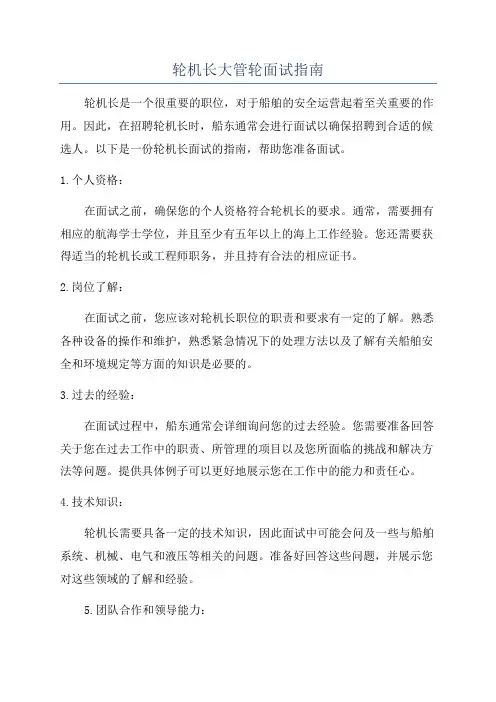
轮机长大管轮面试指南轮机长是一个很重要的职位,对于船舶的安全运营起着至关重要的作用。
因此,在招聘轮机长时,船东通常会进行面试以确保招聘到合适的候选人。
以下是一份轮机长面试的指南,帮助您准备面试。
1.个人资格:在面试之前,确保您的个人资格符合轮机长的要求。
通常,需要拥有相应的航海学士学位,并且至少有五年以上的海上工作经验。
您还需要获得适当的轮机长或工程师职务,并且持有合法的相应证书。
2.岗位了解:在面试之前,您应该对轮机长职位的职责和要求有一定的了解。
熟悉各种设备的操作和维护,熟悉紧急情况下的处理方法以及了解有关船舶安全和环境规定等方面的知识是必要的。
3.过去的经验:在面试过程中,船东通常会详细询问您的过去经验。
您需要准备回答关于您在过去工作中的职责、所管理的项目以及您所面临的挑战和解决方法等问题。
提供具体例子可以更好地展示您在工作中的能力和责任心。
4.技术知识:轮机长需要具备一定的技术知识,因此面试中可能会问及一些与船舶系统、机械、电气和液压等相关的问题。
准备好回答这些问题,并展示您对这些领域的了解和经验。
5.团队合作和领导能力:作为轮机长,您需要领导和管理整个轮机部门的工作。
在面试中,您可能会被询问您在过去的工作中如何与团队合作、激励下属并解决团队内部的问题。
准备好回答这些问题,并提供适当的例子来展示您的领导能力。
6.紧急情况下的应对能力:在海上航行中可能会发生各种紧急情况,轮机长需要能够应对并采取正确的措施。
在面试中,您可能会被问及您在过去的工作中是否经历过紧急情况以及您如何处理的。
准备好回答这些问题,并强调您在应对紧急情况方面的能力。
7.承受压力的能力:轮机长的工作压力较大,面试中可能会询问您如何处理工作压力和长时间的工作时间。
展示您的解决问题和管理压力的能力是很重要的。
8.问题解答:面试中可能会有许多其他的问题,与船舶运作和管理相关。
您需要准备回答这些问题,并且展示您对航海行业和相关问题的了解。
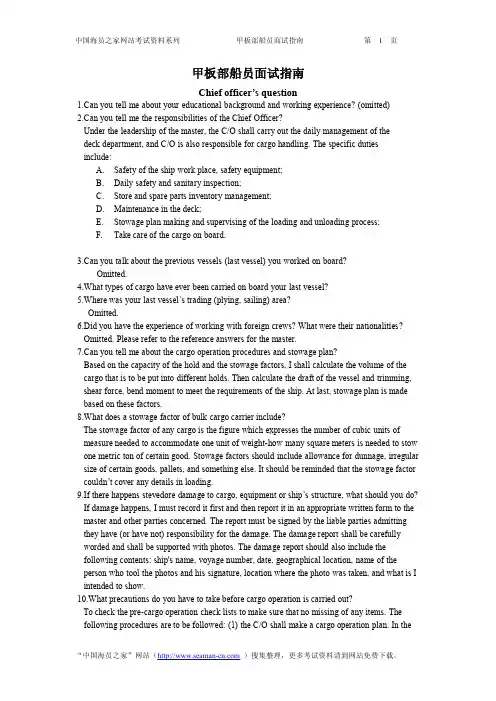
甲板部船员面试指南Chief officer’s question1.Can you tell me about your educational background and working experience? (omitted)2.Can you tell me the responsibilities of the Chief Officer?Under the leadership of the master, the C/O shall carry out the daily management of thedeck department, and C/O is also responsible for cargo handling. The specific duties include:A. Safety of the ship work place, safety equipment;B. Daily safety and sanitary inspection;C. Store and spare parts inventory management;D. Maintenance in the deck;E. Stowage plan making and supervising of the loading and unloading process;F. Take care of the cargo on board.3.Can you talk about the previous vessels (last vessel) you worked on board?Omitted.4.What types of cargo have ever been carried on board your last vessel?5.Where was your last vessel’s trading (plying, sailing) area?Omitted.6.Did you have the experience of working with foreign crews? What were their nationalities? Omitted. Please refer to the reference answers for the master.7.Can you tell me about the cargo operation procedures and stowage plan?Based on the capacity of the hold and the stowage factors, I shall calculate the volume of the cargo that is to be put into different holds. Then calculate the draft of the vessel and trimming, shear force, bend moment to meet the requirements of the ship.At last, stowage plan is made based on these factors.8.What does a stowage factor of bulk cargo carrier include?The stowage factor of any cargo is the figure which expresses the number of cubic units of measure needed to accommodate one unit of weighthow many square meters is needed to stow one metric ton of certain good. Stowage factors should include allowance for dunnage, irregular size of certain goods, pallets, and something else. It should be reminded that the stowage factor couldn’t cover any details in loading.9.If there happens stevedore damage to cargo, equipment or ship’s structure, what should you do? If damage happens, I must record it first and then report it in an appropriate written form to the master and other parties concerned. The report must be signed by the liable parties admitting they have (or have not) responsibility for the damage. The damage report shall be carefully worded and shall be supported with photos. The damage report should also include the following contents: ship's name, voyage number,date, geographical location, name of the person who tool the photos and his signature, location where the photo was taken, and what is I intended to show.10.What precautions do you have to take before cargo operation is carried out?To check the precargo operation check lists to make sure that no missing of any items. The following procedures are to be followed: (1) the C/O shall make a cargo operation plan. In theplan, the following factors shall be considered: the cargo must be stowed in such way that the stability,trim, shearing forces and bending moments are within the limits as laid down by the stability manual; excessive weight on tank tops, between decks and hatch covers must be avoided;and cargo must be stowed and secured on such way as to avoid damage which can result in possible loss of life of property.Preoperation conference with all ship's personnelother officers and crew that are to be involvedin the cargo operation is held to discuss such matters as cargo disposition, numbers of gangs and working hours, usual and special safety requirements, ballasting and deballasting information, special requirements regarding cargo operation, damage prevention and control, personal organization, cargo watch etc. The C/O must ensure that all relevant personnel have fully understood the intended cargo and all usual and special safety and operational requirements.11.What will you do if the cargo damage is found or suspected before loading/during loading?I shall report to the master first and foremost. The master should decide whether to replace the damaged cargo. For the fullset machines and highvalued products (成套设备和高价值的货 物),I must ask for the replacement in the loading port if damages are found. If the damaged cargoes cannot be replaced, then the chief mate shall make remarks on the chief mate’s receipt. If disputes happen on the quantity and quality of the cargoes, I shall, at the discretion of the master, ask the cargo surveyor to do the surveying. If necessary,under the endorsement of the ship owner, I shall write a Letter of Protest (based on the format provided by the company) to illustrate the innocence of the seamen on board.During the voyage, when a very small amount of cargo damages, with the permission of the master, throw away into the sea to avoid any disputes with any third party.12.What are the differences between the B/L and the Mate’s Receipt?Tally Sheet (理货单) is the basis of the Mate’s Receipt. Mate’s receipt is the basis of the B/L. The condition of the cargo is clearly shown on the Chief Mate’s Receipt. It is very important to make sure that the cargo condition on the bill of lading and that on the chief mate’s receipt is the same. If the consigner wants the master to issue clean B/L on the basis of unclean Mate’s Receipt, then the master firstly must ask for permission from the company.If the company agrees, then the consigner must issue reliable Letter of Indemnity or Letter of Guarantee.13.If the draft survey proves a shortage of cargo after loading is completed, what will you do except to report to the Master?Will you make any remarks on the Mate’s Receipt? And what kinds of remarks will you make on the Mate’s Receipt?In this case, I shall report the problem to the master first. With the permission of the master, I shall ask the third party surveyor to do the survey. If the survey shows there is shortage or damage of the cargo, then I shall write remarks on the mate’s receipt showing the loss or damage or shortage.The third party is to be invited to make the objective report on the real quantity of the volume of the cargo. If the cargo is proved to be in shortage, then I shall write remarks on the chief mate’s receipt.15.What do you know about the ISM code?ISM code is the International Safety Management. It is a compulsory rule and regulation on the safety management of the vessel and prevention of sea pollution. Each shipping company andthe vessel should have their own ISM and SMS (safety management system) manuals.16.Have you experienced any onboard internal audit procedures before?The onboard internal audit is carried out at the discretion of the Designated Person of the ship owner.When the auditors come on board, the seamen should provide full support to their jobs.If observation or nonconformity items are found in the audit, these items should be treated with due diligence and rectified on time.17.What is Garbage Management Plan?According to MARPOL 73/78, the plan shall include the procedures for the garbage disposal, and the records that need to be done. The C/O should be responsible for the making of garbage disposal plan for the ship.18.How do you carry out the deck machinery maintenance?Yes,on board the last vessel, I often asked the bosun to organize the ABs and other ordinary sailors to make maintenance for such equipment as windlass (锚机),steering engine, chipping the rust,greasing, derrick, crane,wires,meters and winch (起货机).All the maintenance plans for the machines in the deck department shall be made by the C/O. But the repair of themachines should be made by the engine department.19.As the Chief Officer,what precautions do you have to take to prepare for the PSC(port statecontrol) inspection?The C/O should arrange the checks for the following items: safety equipment, sanitarysituation on board,especially in the deck room, cabin room, the kitchen, cargo operationsafety,documents to be checked. Besides, under the empowerment the C/O should organize the emergency drills.20.What precautions do you have to take before entry into an enclosed work place is permitted?According to checklist, I shall prepare for the standby personnel, ventilation, breathing tool, connecting signals,oxygen, air and poisonous gases testing equipment, portable extinguisher, and other necessary equipment.21.What checks have to be made before any hot work is permitted?I must make sure that:There is no gas leakage on cargo deck or pump room area;The nearby places shall be free of inflammable materials or gases;The area where the hot work is done is not piled with solvents of any kind, including diesel oil, kerosene, paint cleaners an thinners.Gas testing is also important to make sure there is no flammable or toxic gas is present at the work site and that the oxygen content is21% by volume.Ventilation condition should also be checked before hot work.22.On board your previous vessels, how often did you conduct a firefighting drill?The fire fighting drill is carried out on monthly basis.When we did the firefighting drill,we just did it as if the real fire disaster had happened.23.What is the C/O responsibility with regards to cargo operation?The chief officer is in charge of safe handling of all cargo operation. However he must submitall cargo plans to the master for approval, as well as discuss any critical stage of cargo operation with the Master,before such stage being undertaken. He is also responsible for proper completion of cargo records, time sheets, performance logs and other paperwork related tocargo operation.24.What is the C/O’s responsibility with regard to deck maintenance?The chief officer should prepare the deck maintenance scheduleboth the longterm and short term and discuss the schedule with the Master.He will be in charge of the deck department personnel and overseeing their duty work when they do the maintenance work.25.The charted depth of anchorage is40 meters, usually how do you drop the anchor?Before dropping the anchor,we should make sure that the windlass and the brakes are in good condition,study the weather and water depth and sea condition. To make sure whether there is good holding ground. Take into account the duration of the anchorage action.During the anchorage, lower the anchor until it touches ground, then disengage and slag the chain cable until the length is paid out. Use main engine to move it to stretch the cable. Do not use excessive weight for the cable.The length of the cable must be decided by the master in advance. If the anchorage depth is more than50 meters, to add additional shackle after 15meters.No matter how deep the water is,at least two shackles should be remained on board.26.If water depth is more than 80 meters, is it possible for you to drop the anchor?Except in emergency situation, dropping anchor in this depth of water is very dangerous. So if it is very important to drop the anchor,then the geographical condition (sea bed and adjacent area),weather condition must be carefully studied before dropping. Besides, it is veryimportant to have a prediscussion or meeting with relevant seamen before the work is done.27.How to keep the proper ventilation during the voyage? For example, your ship loaded the steelcoil at Constansta on December and the discharging port will be in Singapore.In order to prevent rust formation on the surface of the steel, I must make sure the temperature in holds is higher than the dew point at any times. Ventilation is to be made on the condition of dew point and try to lower the dew point.28.How do you maintain the minimum under keel clearance (UKC) when the vessel duringpassage/in fairways/inside ports?In different places, the UKC may vary a little bit. But, generally,during passage,the UKC should be20% of the load draft; in fairways,10% of the load draft; and inside the port, 10% of the load draft. The reference data are subject to the regulations of the port authority.29.In case of cargo damage (for example, before the vessel arrive at the discharging port, whenopening the hatch, you find the quality of the surface cargo had changed) how would you handle it?Well,I have to the quantity of the cargo whose quality has changed. If the cargo is in small quantity,then I shall dispose it myself. If it is in large quantity,I shall ask for decision from the master.30.What is the sensitive cargo?And which cargo was defined as the sensitive cargo by P& I?The cargo is particularly susceptible to moisture damage and special attention shall be required in taking care of this type of cargo during voyage. Cement,grain, and sugar are usuallydefined as sensitive cargoes. In operating the sensitive cargoes, great care should be taken. 31.How do you know whether the cargo holds are fitted for loading?According to the requirements of the charterer party’s requirements, I shall check it to see whether it meets the charter’s demands. Then, I will make my own judgment. If the holds arenot suitable for loading any type of cargo,I shall report this to the master and ask him todecide on this.32.Briefly explain general requirements of grain cargo carriage.1) Preparation for the space where the grain is going to be put.The hold into which the grain is to be loaded is to be very clean and free from scale and bad smell. Any open bilge shall be clean and dry. The tank top should be clean, having no stain and dry.Any timber boards must be in good condition and covered with tarpaulin. The rear sides of the brackets and beams, piping etc shall be completely washed and cleaned of all cargo residue and dust. All residues from the previous cargo shall be removed. And if the ship was used in carrying grain in the previous voyages, and if insects are found in the hold, then the holds shall be fumigated with insecticide.2) VentilationGrain is a kind of cargo that can self heat and condense and can absorb moisture. Without good ventilation, the cargo can easily deteriorate. With bulk grain, air is to be blown to the surface of the grain continuously on daily basis in order to remove the remitted air from the cargo. The temperature of the cargo shall be tested by thermometer on daily basis and be recorded in the log book.For detailed answer,please refer to the IMO Grain Rule. (IMO Resolution A714)3) CODE OF SAFE PRACTICE FOR CARGO STOWAGE AND SECURING.33.How to conduct ventilation for hygroscopic cargo from warm to cold area voyage,and fromcold to warm voyage? How about the nonhygroscopic cargo?For the hygroscopic cargo: From warm to cold voyage, ventilation is very critical. Ventilation should be as strong as possible in the beginning, eventually the outside dew point will be too low.This is a very difficult voyage situation in which to arrange satisfactory ventilation. From cold to warm voyage, the ventilation is not necessary.For the nonhygroscopic cargo: from cold to warm voyage, no ventilation is needed, and cargo sweat would occur on the surface of the stow if relativel7 warmer moisture laden air wasadmitted. From the warm to the cold voyage, no ventilation is needed because ship sweat is inevitable but cargo will be unaffected unless condensation drips back on the stow.34.How to prevent cargo damage caused by rain or seawater?Before the voyage, to check whether the hatch cover is closed properly,and make sure that tight water condition is in good order.To make sure suction boxes and man holes are properly closed; to check the bulkhead(压载舱) of adjacent ballast tank.35.When you are ready for pilot, what preparation should you make?Firstly,contact the pilotage station to arrange for the pilot to come on board;Secondly,contact the coming pilot and discuss with him on the vessel’s heading position and speed at the time of his boardingThirdly,deck watch duty officer shall supervise the embarkation and disembarkation of the pilot to ensure his identity and his safety.Fourthly,the pilot ladder must meet the US Coast Guard and IMO’s standards.Fifthly,prepare the ladder well and hoist the Golf flag.Sixthly,give a good reception to the pilot by the officer and master.Lastly,when the pilot is on board,H flag should be hoisted.36.When you pass by the Panama Canal,what should you pay attention to? Why?The turn of bilge radius should be made known to the pilot.According to the regulations there, the turn of bilge radius of the vessel cannot be over 12.04 meters in the fresh water area. No bilge water is allowed to be remitted.As a precaution, we should check with the MR Notice and apply for correction if on time.ETA7 days before we pass by the Canal,we should report to the Canal authority on the vessel condition.37.How often did the superintendent come on board to check? If the superintendents and the P&Ipeople do not come on board for checking, if cargo damage happens, what should you do to deal with the situation?On my last ship, the superintendent came on board whenever the vessel came to large ports.If the superintendent does come on board the ship, we will just report the accidents to the ship owner and ask for their proposals. But of course,master and I will solve some minor problems.Another thing38.What materials and information do you need when you make the passage plan?The passage plan shall contain all the charts required and shall locate all the information concerning area of intended area.The information needed for the passage plan shall be found from the Sailing Direction, List of Lights,Tide Tables,tidal Stream Table,Guide to port Entry, Deep Draft Vessel Planning Guide,The INO Ship Route Guide, Guide to Tanker Port,various ports’information booklets, government and port regulations, Navigational Warnings, pilot Charts,Notice to Mariners,Weather Information, and so on.39.Do you often change the ballasting water? In maintaining the ballasting water,what particularattention should you have to pay to?Not often, except that in some countries’seacoast where the PSC requires the change ofballasting water in certain area to prevent the sea pollution.Pumpingin andout the ballasting water on time is very important to keep the stress of the vessel in good condition (有利于保持船处于好的拱垂和强度). Under heavy weathercondition,it is necessary to test the ballasting and bilge water more often to make sure the stability of the vessel.40.What should you pay attention to when you the vessel load coal?Trimming is very important to make sure that the cargo is even loaded. The coal is liable to get fire so you have to be very careful in fire ignition and firefighting equipment should be ready.Air in the cargo space should be regularly checked. Bilge water should be testedsystematically to see whether there is any water leakage.During the voyage,the ventilation is very important. No ventilation is a good idea. Theoxygen’s entering is very important factor that can make the fire disaster.Also, you have to measure the temperature often; and if the temperature is too high, spray water to lower the temperature.41.What are the functions of the B/L? What is clean B/L and what is unclean B/L?B/L has the three very important functions: It contains evidence of the terms of the contract of carriagea promise to carry and deliver the cargo. It contains the apparent order,condition, andquantity or weight of goods at the time of shipment. It is also a document of title (property) of the cargo.Clean B/L is the one on which there is not any remark of cargo loss, shortage or damage.Unclean B/L is also called claused B/L, which carries some remarks of cargo damage, quantity shortage and so on.42.What is back dated or antidated B/L? What is advanced B/L?Back date B/L refers to the B/L whose issuing date is earlier than the virtual loadingcompletion date.Advanced B/L refers to the B/L that is signed and issued by the carrier before the completion of loading. Both back date and advanced B/L will bring some dangers and liability to the ship owner and charterer.43.In order to prevent stowaway,what precautions should you take before the vessel is sailingfrom a port?Before departure from any port,crew check has to be made and any ship has to be checked and searched for stowaway.The following spaces shall be searched thoroughly: void space, chain lockers, funnel, and other places where the stowaways can be found.If stowaways are discovered before the ship sails:Arrange for his disembarkation usingservices of the local agent; notify the company,take necessary steps to prevent any further reoccurrence.44.Who should not be allowed to have the shore leave at the same time?In view of the jobs on board,the following positions and ranks can not be allowed to haveshore leave at the same time: Master and C/O; C/E and first engineer; C/E and electrician; Bosun and Pumpman (in tankers); chief cook and second (or mass boy); C/O and pumpman (in tankers).Every member who wants leave the ship must check with the department head for permission and return back to the vessel on time.45.What is the maximum blood alcohol concentration (BAC) rate on board?According to the ISM, the BAC shall not be more than0.04% by weight any time when being tested. But watch keepers is not allowed to drink any alcoholic beverage 4 hours before their watch.46.How to operate incinerator? What kind of garbage can not be thrown into incinerator?Fist,check the oil level in the oil tank; open residue cook and discharge oily water; heating the bilge oil in the tank to70 to80 centigrade; start the incinerator.In the beginning, combustion bilge oil with light oil,and after the water content in bilge oil is comparatively low,stopsupplying light oil and use bilge oil only.Attention: the temperature in combustion cannot be higher than the stipulated figures of the incinerator (usually not more than 500 degree incentigrade.).The following garbage can not be thrown into the incinerator:l Any containers which have contained gases under pressure, or aerosol cans into the incinerator.l The materials that may produce harmful gases or ashes;l The materials that may produce high temperature and prolonged incineration of such materials that may cause damage to the incinerator.47.What should a Muster List include? What kind of Muster Lists did you have on the last vessel?The Muster List should include the following:(1) Details of emergency alarm signal; (2) How shipabandon will be given; (3) Officerresponsible for the maintenance of fire fighting equipment and life saving appliances, which should always in good condition and ready for immediate use. (4) Substitutes for the key personnel who may become disabled; (5) Specify the boat to which each person belongs and duties to be performed by abandon ship situation; (6) The specific group to which person belongs and general duties during various emergencies; (7) Any additional or specific duties; (8) Specific assembly point of each group.The muster list must be ready before the ship sails.We had the following Muster Lists on board the last vessel:General emergency, fire fighting, fire in the engine, emergency steering, abandonship,man overboard, oil pollution prevention station, and so on.48.What is heavy weather condition? Under the heavy weather conditions, what preparation should you make in sailing? During sailing, what should you be careful about?After the heavy weather,what should you check?Heavy weather,in principle, refers to the navigation under weather conditions of wind force of6 or above on the Beaufort scale and wave height of greater than 5 meters.During the heavy weather conditions, the master shall make the following preparations:(1) Select a route that avoid that heavy weather area,if this is possible;(2) Inform the crew of the predicted heavy and issuing warning. Make sure that thewarning is known to all the seamen on board.(3) Instruct the C/O to check the hull strength based on stowage calculations, cargo loadingand stability documents. If the ship is not carrying cargo,the master shall ballast the ship to increase the draught and take action to prevent propeller racing, reduce oscillations and slamming of the ship.(4) Make sure the following holes are closed: hatches, cargo hold, bosun’s store, manhole;accesses to accommodation spaces and steering gear room; tank air pipes, sounding caps; all water tight doors and water tight openings on the ship;(5) Ensure that the C/O adopts measures to prevent movement of cargo and other objectson various parts of the ship;(6) Ensures that the lashes cargo gears such as derricks, cranes and life boat;(7) Ensure that C/O check the conditions of the stowage of anchors and anchor chains;(8) Critical checklists are kept in the plastic folder on bridge and to be used as reference. 49.Under heavy weather conditions,what preparation should you make before sailing?If navigating in heavy weather,the following should be paid attention to:(1) Adopt measures to prevent slamming and pounding of the ship, considering thefrequency of encounters with swells and change speed or course if necessary;(2) The watch keeping officer shall change over to parallel operation of the steering gear,ifpossible;(3) If possible, change the auto pilot to“rough sea mode” or change over to manual mode;(4) Master shall frequently check the weather and sea conditions, observe future changes andjudge of there is a problem with the present course and speed;(5) Report the weather to the nearest port authority or the ships in the vicinity or the badweather and ask them to be careful and warm them.(6) The master shall check the abnormalities whenever possible to make the ship in goodcondition.After the heavy weather, the master shall carry out the following checks; the hull and cargoes; if abnormalities are found, report to the company as soon as possible.50.If the stevedore workers damage part or the whole of the crane,derrick or any other equipmenton board,what should you do?Firstly,I shall ask the duty officer have a careful supervision when the stevedore workers are loading and unloading cargo and ask the duty officers to report to me any incident or anydamage the workers have done to the vessel equipment.If equipment damages occur,usually,I will see how serious the damage is. If the damage is serous, I shall report to the master immediately.If the damage is not very serious, I shall ask the stevedore company to make repair and correction.At least,I shall ask the stevedore the a acknowledgement of liability.But anyway,I shall not allow the stevedore workers to leave the vessel until the damage problem is settled properly.51.Before drydocking for the vessel, what should a C/O do?The C/O shall prepare a detailed repair list for the approval of the master and the company. The C/O should also make out a safety procedure before drydocking. If empowered by the master, the C/O may make an arrangement plan for the assignments for the deck officers and ordinary seamen during drydocking When the repair work is being done, the C/O should have a good supervision on the jobs and ensure the safety of workers and the seamen.52.How do you balance the interests of the shipowner and those of the charterer?I think both interests are very important to me. The shipowner pay me but salary is from thecharter.In order to make both sides happy. I shall take good care of the cargo and at the same time, I shall implement my duty at the order of the shipowner and try to safeguard the interests of the shipowners.53.What do you know about BC Code?BC code refers to IMO’s Bulk Cargo Code. In this code, bulk cargo operation procedures are stated. This is a very important manual and the chief officer must study it with care and follow the instructions in the code in practical work, especially when he makes the stowage plan.Questions for 2/O二副面试前主要应该准备关于职责范围内的问题,如如何画海图、如何修正海图、制定 航路计划、值班时所要注意的问题等等。
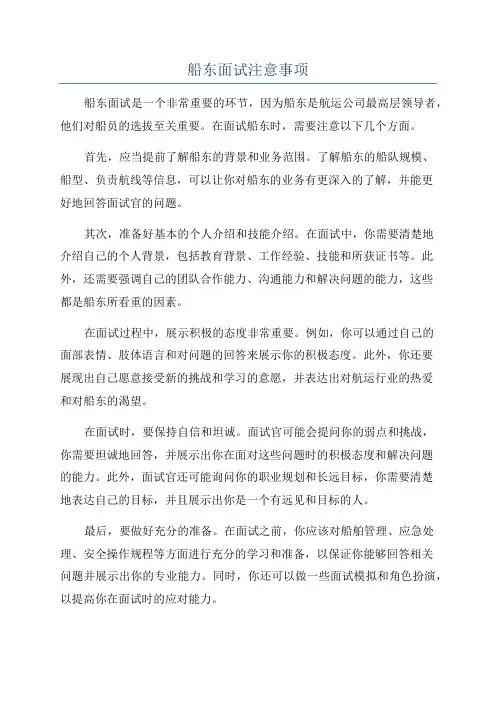
船东面试注意事项船东面试是一个非常重要的环节,因为船东是航运公司最高层领导者,他们对船员的选拔至关重要。
在面试船东时,需要注意以下几个方面。
首先,应当提前了解船东的背景和业务范围。
了解船东的船队规模、船型、负责航线等信息,可以让你对船东的业务有更深入的了解,并能更好地回答面试官的问题。
其次,准备好基本的个人介绍和技能介绍。
在面试中,你需要清楚地介绍自己的个人背景,包括教育背景、工作经验、技能和所获证书等。
此外,还需要强调自己的团队合作能力、沟通能力和解决问题的能力,这些都是船东所看重的因素。
在面试过程中,展示积极的态度非常重要。
例如,你可以通过自己的面部表情、肢体语言和对问题的回答来展示你的积极态度。
此外,你还要展现出自己愿意接受新的挑战和学习的意愿,并表达出对航运行业的热爱和对船东的渴望。
在面试时,要保持自信和坦诚。
面试官可能会提问你的弱点和挑战,你需要坦诚地回答,并展示出你在面对这些问题时的积极态度和解决问题的能力。
此外,面试官还可能询问你的职业规划和长远目标,你需要清楚地表达自己的目标,并且展示出你是一个有远见和目标的人。
最后,要做好充分的准备。
在面试之前,你应该对船舶管理、应急处理、安全操作规程等方面进行充分的学习和准备,以保证你能够回答相关问题并展示出你的专业能力。
同时,你还可以做一些面试模拟和角色扮演,以提高你在面试时的应对能力。
总之,面试船东是一个非常重要的环节,需要精心准备和充分展示个人能力。
通过提前了解船东的背景和业务、准备好个人介绍和技能介绍、展示积极的态度、保持自信和坦诚、做好充分准备,你将增加在面试中获得成功的机会。
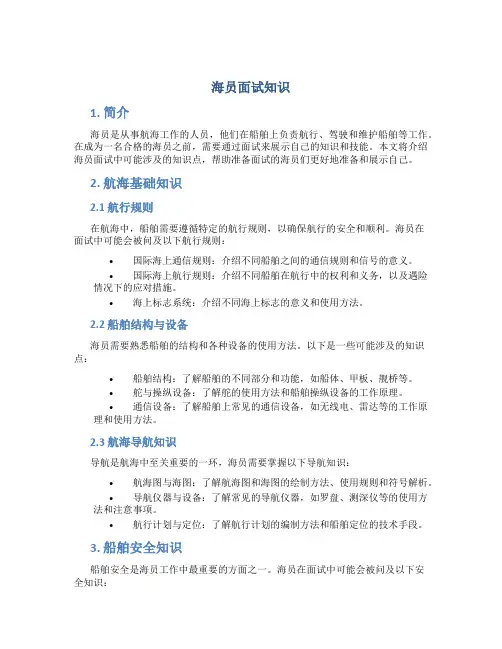
海员面试知识1. 简介海员是从事航海工作的人员,他们在船舶上负责航行、驾驶和维护船舶等工作。
在成为一名合格的海员之前,需要通过面试来展示自己的知识和技能。
本文将介绍海员面试中可能涉及的知识点,帮助准备面试的海员们更好地准备和展示自己。
2. 航海基础知识2.1 航行规则在航海中,船舶需要遵循特定的航行规则,以确保航行的安全和顺利。
海员在面试中可能会被问及以下航行规则:•国际海上通信规则:介绍不同船舶之间的通信规则和信号的意义。
•国际海上航行规则:介绍不同船舶在航行中的权利和义务,以及遇险情况下的应对措施。
•海上标志系统:介绍不同海上标志的意义和使用方法。
2.2 船舶结构与设备海员需要熟悉船舶的结构和各种设备的使用方法。
以下是一些可能涉及的知识点:•船舶结构:了解船舶的不同部分和功能,如船体、甲板、舰桥等。
•舵与操纵设备:了解舵的使用方法和船舶操纵设备的工作原理。
•通信设备:了解船舶上常见的通信设备,如无线电、雷达等的工作原理和使用方法。
2.3 航海导航知识导航是航海中至关重要的一环,海员需要掌握以下导航知识:•航海图与海图:了解航海图和海图的绘制方法、使用规则和符号解析。
•导航仪器与设备:了解常见的导航仪器,如罗盘、测深仪等的使用方法和注意事项。
•航行计划与定位:了解航行计划的编制方法和船舶定位的技术手段。
3. 船舶安全知识船舶安全是海员工作中最重要的方面之一。
海员在面试中可能会被问及以下安全知识:3.1 灭火与应急措施海员需要具备基本的灭火和应急处理知识,以下是一些可能涉及的知识点:•灭火器的种类与使用方法:了解不同类型灭火器的使用场景和操作方法。
•灭火与应急预案:了解船舶上的灭火与应急预案,包括应急通信、紧急疏散等。
3.2 船舶安全设备船舶上有各种安全设备,以下是一些可能涉及的知识点:•救生设备与应急装备:了解救生艇、救生圈等救生设备和应急装备的使用方法。
•消防设备与防护装备:了解船舶上常见的消防设备和防护装备,如火警报警器、防护服等。
船员面试技巧和注意事项面试或称应聘评估(interview/employ evaluation)是一种通过会面、电话交流等方式使得雇主和应聘者彼此了解,确定是否达成聘用关系的考核过程。
随着航运业的发展,船员市场化趋势越来越明显,船员面试已经成为船员应聘工作的一个重要手段和必要环节。
本文就船员面试相关知识和技巧作简单介绍。
一. 船员面试方式通常船员面试有四种方式。
1. 口头提问和回答(Face-to-face Questioning and answer)。
船员面试中,考官最基本的办法是面对面口头提问,即考官提问,船员回答。
有时,考官进行口头提问时会穿插一些笔答问题。
这些笔答题可能包括写一篇简单的英文、做一些非专业英文测试题、阅读并翻译一篇文章,就阅读材料回答一个或几个问题,直接回答一些问题等等。
总之,面试中穿插的笔试一般都不会很长、很复杂。
回答这类问题时,首先不要紧张,熟悉问题要求和问题内容,要在动笔或电脑之前稍做思考,在脑海中先规划一下答案的提纲。
同时,在做答时还要注意字迹清晰、书写工整、条理清楚。
2. 电话面试(Telephone Interview)。
电话面试是一种非常通行的船员面试方式,原因是船员居住地比较分散,而船东又多在国外,对于零散外派来说,电话面试对个方面来说是一种非常经济的办法。
电话面试通常时间紧,没有时间准备。
如果预约的面试时间对你来说真是太紧,你可以要求推迟一下,以便有时间调整你的情绪和心情,也有时间大致翻阅一下常用船上英文用语和电话会话用语。
电话面试前,最好在电话旁边放一份自己的简历表,因为考官经常要你简单介绍一些你的工作经历和个人情况,有一份书面简历,便于自己回答诸如船名、吨位、航行区域、工作时间、主机辅机的机型和功率等问题时得心应手。
电话旁还应该放一支钢笔和一两张纸,以便面试时随时记下考官的问题,特别是比较长的问题。
另外,接电话时最好显得职业化一些,比如,电话在预约的时间响了,你可以说:“Hello, this is Wang Lin ,a second engineer ,speaking.”(您好,二管轮王林在接听您的电话)。
面试船员题纲
以下是一些可能出现在面试船员的题纲:
1. 个人背景和经验:
- 介绍一下自己的背景和教育经历。
- 你有什么与航海相关的工作经验或实习经历?
- 你对航海行业的兴趣是如何产生的?
2. 船员技能和资质:
- 你拥有哪些航海技能和资质?例如航海证书、船员证书等。
- 你对航海器材和设备的了解程度如何?
- 你在船上的职责和责任是什么?
3. 安全意识和应急处理:
- 在船上,你如何确保船员和船的安全?
- 你如何处理紧急情况,例如火灾、漏水或人员受伤?
- 你对海上救援和应急处理的了解程度如何?
4. 团队合作和领导能力:
- 描述一次你在团队中发挥领导作用的经历。
- 你如何处理与船员或其他团队成员之间的冲突?
- 你认为一个有效的船员应该具备什么样的团队合作能力?
5. 航海知识和导航技能:
- 你对航海知识和导航技能的了解程度如何?
- 你如何使用导航设备和工具进行航行?
- 你对航海规则和法规的了解程度如何?
6. 压力处理和适应能力:
- 描述一次你在压力下工作的经历,你是如何处理的?
- 在航海工作中,你如何应对长时间的工作和压力?
- 你如何适应船上的生活和工作环境?
7. 未来发展和目标:
- 你对航海行业的未来发展有什么看法?
- 你的职业目标是什么?你希望在航海行业中发展到什么样的职位?
- 你打算如何继续提升自己的航海技能和知识?
这些题纲旨在了解面试者的航海背景、技能、经验和职业目标。
同时,也希望通过相关问题了解他们的安全意识、团队合作能力、压力处理能力以及对航海行业的认知和发展趋势的了解程度。
船员面试(英语)必读。
前言:船员,一个神圣而神秘的职业,也就导致了很多人对它无知和误解。
但在经济全球化今天,没有它是不行的。
因为90%的货物运输靠的是海运,因此海运对于经济发展至关重要,从而船员这个职业也就非常重要。
但每年国内毕业的船员只有一万五左右,远洋船员占的比重也比较小,从而导致了远洋船员的紧缺。
众所周知,远洋船员的足迹踏遍五大洲四大洋,要和不同国度不同肤色的人进行交流,交流的通用语言是英语,所以英语就决定着一个远洋船员能否适任他所担任的职务了。
你很有才,很庆幸通过了面试。
但九九八十一难你并没有完全通过,下一个摆在你面前的是我们的适任证书,没有它,你还是一文不值。
在适任证书的考试科目里面不但没有取消英语的存在,而且对英语要求的更高,既有阅读又有听力还有口语。
这也就促使了我们谈之色变的专业英语的登场。
如果你的如愿的签到了你想要去的公司,并如愿的拿到适任证书,也请你记得英语对于你依然很重要,因为你从事职业的特殊性,你的噩梦还没有结束。
作为船员都知道我们的职务晋升也是要考试的,这个考试和陆地上的晋升考试可谓是天壤之别,需要你去学校里去培训,去过每天只能睡4~6个小时的日子。
即使这样也有很多人是一考再考,究其原因,大部人坦言被英语扼杀在摇篮之中。
所以衷心的希望你还记得英语对于你的重要性。
丢了它就相当于丢了你作为船员的资格。
生活对于船员总是那么的顽皮,英语也没有随着通过所有证书而失去,反而它还像口香糖一样粘着你,只要你还想吃船员这碗饭,你就不能把它剔除。
曾经一位老船员给我们讲过这样的一个故事,话说有一位船员平时工作还能过得去,硬伤就是英语不好。
有一次,他时运不济受伤了必须住院治疗,这也就圆了他想要享受西方医疗的美梦了。
真是不住不知道,一住吓一跳,在哪没有人和他玩耍,一日三餐只吃面条。
不知道的还以为公司怎么着他了呢,而实际上是因为他英语不好,没有办法与人沟通,更让人难以置信的是对于食物的英文名他就知道“面条”。
第1篇一、基础知识测试1. 请简要介绍船舶的类型及其特点。
解答:船舶主要分为客船、货船、油轮、化学品船、液化天然气船等。
客船主要用于运输旅客,货船用于运输货物,油轮用于运输石油,化学品船用于运输化学品,液化天然气船用于运输液化天然气。
每种船舶都有其特定的设计特点和适用范围。
2. 请说明船舶的主要组成部分及其功能。
解答:船舶的主要组成部分包括船体、船机、船装、船电、船务等。
船体是船舶的主体,负责承载货物和人员;船机包括主机、辅机等,负责提供船舶的动力;船装包括船舱、甲板、锚泊设备等,用于装载货物和人员;船电包括发电设备、照明设备等,为船舶提供电力供应;船务包括船舶管理、船员管理等,负责船舶的日常运营。
3. 请解释船舶的浮力原理。
解答:船舶的浮力原理是阿基米德原理,即物体在液体中所受的浮力等于物体排开的液体的重量。
船舶通过设计使其浮力大于重力,从而能够在水中漂浮。
4. 请简要介绍船舶的航行原理。
解答:船舶的航行原理是通过船舶的动力装置产生推力,使船舶前进。
推力可以通过螺旋桨、喷水推进器等方式实现。
5. 请说明船舶的稳性原理。
解答:船舶的稳性原理是指船舶在受到外力作用时,能够保持平衡的能力。
船舶的稳性取决于船体的形状、重心位置、稳心高等因素。
二、船舶操作技能测试1. 请描述船舶进出港的流程。
解答:船舶进出港的流程如下:(1)船舶提前向港口管理部门申请进出港手续;(2)船舶在规定的时间内抵达港口,接受港口管理部门的检查;(3)船舶进入锚地,等待泊位;(4)船舶在接到泊位通知后,前往泊位;(5)船舶停泊后,进行货物装卸、人员上下等作业;(6)船舶完成作业后,再次向港口管理部门申请离港手续;(7)船舶离开港口,继续航行。
2. 请说明船舶如何进行靠泊和离泊操作。
解答:船舶靠泊和离泊操作如下:(1)靠泊:船舶在泊位处,通过调整航向和速度,使船艏对准泊位,然后使用锚泊设备或系泊设备将船舶固定在泊位上。
(2)离泊:船舶在离泊前,先将锚泊设备或系泊设备解开,然后调整航向和速度,使船舶离开泊位。